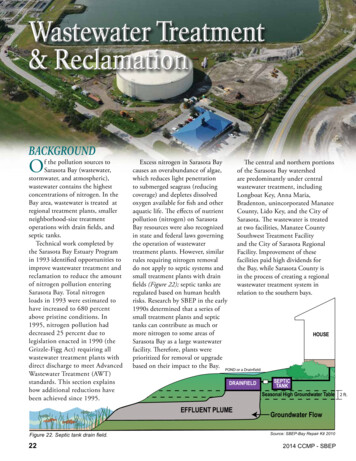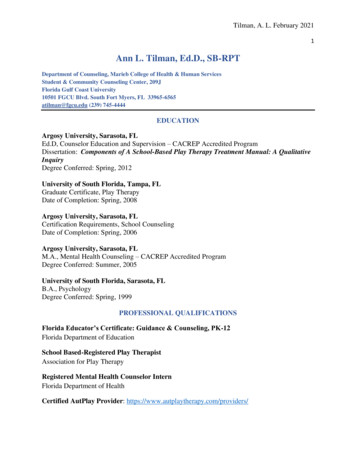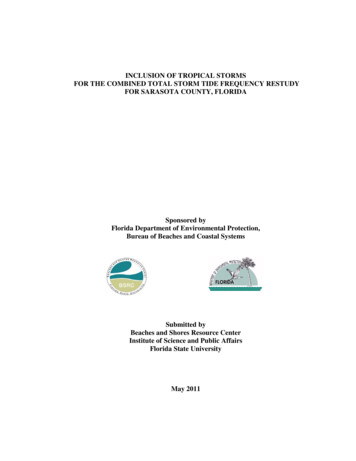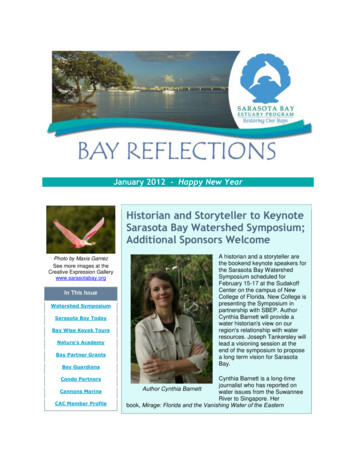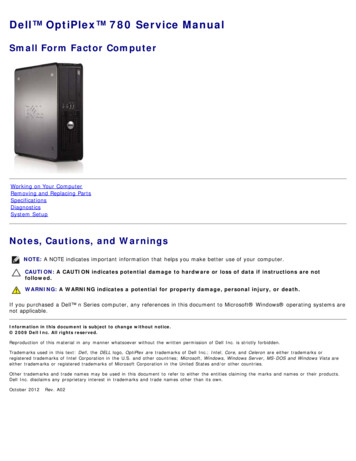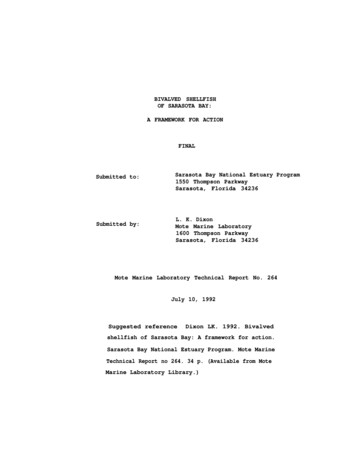
Transcription
BIVALVED SHELLFISHOF SARASOTA BAY:A FRAMEWORK FOR ACTIONFINALSubmitted to:Submitted by:Sarasota Bay National Estuary Program1550 Thompson ParkwaySarasota, Florida 34236L. K. DixonMote Marine Laboratory1600 Thompson ParkwaySarasota, Florida 34236Mote Marine Laboratory Technical Report No. 264July 10, 1992Suggested referenceDixon LK. 1992. Bivalvedshellfish of Sarasota Bay: A framework for action.Sarasota Bay National Estuary Program. Mote MarineTechnical Report no 264. 34 p. (Available from MoteMarine Laboratory Library.)
TABLE OF CONTENTSPaqeCoverTable of ContentsList of FiguresList of Tablesiiiiii1I.Project SummaryII.Background4III.Study Design / Methods and Rationale7Methods and Rationale - Population SurveysMethods and Rationale - Tissue Contaminants78Results12Population Surveys - ResultsBacteriological Contaminants - ResultsMetals - ResultsToxic Organics - Results12141517V.Management Recommendations and Research Needs20VI.Literature Cited24IV.i
LIST OF FIGURESPageClassification of Shellfish harvesting waterswithin Sarasota Bay. Palma Sola Bay temporarilyclosed since 1981.29Results of clam population survey, abundance,during the spring and fall seasons.30Stations where no clams were found during eitherpopulation survey.31Figure 4.Stations with mean clam size less than 100 mm.32Figure 5.Areas of oyster reefs, clumps, or bars withinSarasota Bay.33Geographic distribution of lead and totalchlorinated pesticides in oyster tissue. Mean andstandard deviation of all samples for thestation.34Figure 1.Figure 2.Figure 3.Figure 6.ii
I.Executive SummaryStationary bivalved shellfish were selected for a contaminationassessment of Sarasota Bay, as an organism which integrates the exposureconcentrations of contaminants over a finite period of time (weeks tomonths). Bivalves, as filter feeders, are exposed to large volumes ofwater and feed on suspended particulates which typically contain the bulkof chemical contaminants. The resultant tissue concentrations are usedas a measure of the present-day chronic contamination exposure, as opposedto the instantaneous or historical conditions deduced from water columnand sediment samples.The study emphasized two recreationally important and edibleshellfish, oysters (Crassostrea virginica) and hard clams or quahogs(Mercenaria spp.), either of which offered a fairly ubiquitousdistribution within the study area, or for which a substantial nationaldatabase existed for contaminant levels.Field and laboratory work wasdesigned to survey the populations of the two species and to determinecontamination levels in the edible tissues of these organisms, includingpathogenic bacteria, metals, pesticides, and petroleum based polynucleararomatic hydrocarbons (PAH).The study originally was structured to evaluate contaminants duringboth dry and wet seasons, but low rainfall amounts for the year preventedthe collection of what might be presumed to be "worst case", summer wetseason conditions when contaminants loadings and bacterial populations aremaximized.No formal health risk or stock assessment was conducted.One-quarter of the 169 stations had no clams reported during eithersampling, and yields at three-quarters of the stations were very low.Stations where no clams were found were concentrated along the easternshore of Sarasota Bay and near Midnight Pass. The lowered abundances onthe eastern shore have been reported from relatively pristine areaselsewhere and may be linked to physical factors. The lack of clams nearMidnight Pass is primarily attributed to episodic low salinity events.Conditions have been favorable for clam sets in the past, but this studycannot establish whether the dead clams observed in the area settledbefore or after the closure of Midnight Pass. The larger 'chowder' clam1
predominates in all areas due to predation, rapid growth rates, andpotentially poor or erratic recruitment.Oysters are also common in the area and are most abundant in thebays and tributaries south of Big Pass. Here, larger watersheds andreduced volume of receiving waters maintain more favorable loweredsalinity regimes than in the northern portion of the study area, andconsequently exclude predacious molluscs in particular. On the whole,however, oysters are restricted by predation to an intertidal habitatwhere reduced feeding times produces smaller, less commercially desireableorganisms.Fecal coliforms in water at over half of the stations slightlyexceeded the National Shellfish Sanitation Program (NSSP) criteria. Notissue exceeded the NSSP criteria for fecal coliform or total platecounts. Bacterial counts at sampling times did not indicate highlypolluted conditions and suggest that the major groups of vibrios andaeromonas are a part of the normal ecosystem and not of human fecalorigin.Oyster tissue metals were more useful for detecting stationdifferences than were Mercenaria tissues due to broader rangesencountered. There was no geographic variation for mercury in eitherspecies, which implies that mercury is not associated with any major pointsources in the study area. Individual stations noted for comparativelyhigh metal content included Hudson Bayou, Bowlees Creek, Phillippi Creek,and South Creek. In relation to Florida Gulf coast values, Sarasota Bayoysters are well above average for lead and the Hudson Bayou concentrationexceeded the highest lead value reported for either Florida or the nation.No station averages of tissue concentrations exceeded Food and DrugAdministration (FDA) action levels for mercury. Tissue levels of copperand zinc indicated that oysters in Phillippi Creek, Hudson Bayou, andpossibly South Creek may suffer from impairments such as altered shellthickness and abnormal larvae. Sediment concentrations indicate that moreextensive impacts could be expected in some areas.While chlorinated pesticides were evident in many tissue samples,most concentrations were low. No station with detectable pesticides inthe spring reported those same compounds during the fall sampling,2
indicating that sources of pesticides to the study area were intermittent.No pesticide exceeded the FDA action levels, but oysters from PhillippiCreek, Blackburn Bridge, and Hudson Bayou were comparatively high inconcentrations of specific pesticides. Trace amounts of the labileorganophosphate chlorpyrifos (dursban) were detected in both clam andoyster samples, indicating some influx of pesticides currently in use.Analyses of shellfish tissues detected no quantifiable levels ofPAH, although trace amounts were found at some stations. The compoundspresent indicate that the PAH were derived primarily from pyrogenic orcombustion sources. The stations were distributed broadly and the lowconcentrations of PAH detected in Sarasota Bay shellfish indicated edimentconcentrations of these compounds indicated that ecological impacts maybe expected in some locations.Feasibility of aquaculture or other commercial efforts within thestudy area is deemed low for the following reasons: 1) the frequentoccurrence of toxic phytoplankton blooms ("red tides") which have closedshellfish beds 37 percent of the time in the last 13 years, 2) the highdegree of adverse urban and recreational boating impacts on water quality,3) the relatively small area of approved waters, 4) the poor shippingcharacteristics of dominant local Mercenaria species, 5) the lack ofsubtidal oyster habitat and larger individuals in approved areas, and 6)the difficulty of obtaining leases of subtidal State lands.Resource enhancements at this time can include both seeding of clamsand cultch placement for oyster spat to increase the populations, but willnot likely result in any direct increase in recreation potential.Harvestable individuals would likely remain low unless 1) salinity regimeswere radically restored (oysters), 2) non-point source loadings werereduced, 3) regions nearer tributaries reclassified for harvest, and 4)shore access improved. Reclassification of any areas for additionalharvests will not occur without substantial reductions in non-point sourceloadings of bacteria and other contaminants.There are, however, valid ecological inducements for theseenhancements. As filter feeders, both clams and oysters have thetheoretical potential to improve the water clarity of Sarasota Bay,3
particularly if water clarity impairments are linked to phytoplanktonlevels. Other benefits of enhancing shellfish populations wouldinclude increased biomass of the estuary, support of other species,additional habitat complexity, increased shoreline stability, and reducedsediment resuspension through wave damping.Research needs noted during this project include the quantificationof airborne loads of metals and PAH in relation to surface runoff,relevant for assessing whether conventional non-point source controls canachieve significant reductions in contaminants. Little is known onpopulation dynamics, including recruitment, predation pressures, andharvesting pressure, which should be quantified to manage the resource andprotect from overharvest. Mapping of oyster resources should be updated.Historical salinity regimes in the southern study area could be identifiedby morphological characteristics of current and indian midden oystershell. If NPS controls improve, a formal contaminant specific health riskassessment and recreational effort assessment will become necessary, aswould a true wet season tissue sampling. The suite of analyticalcompounds should also be further expanded to include selected PCB isomers.II.BackgroundOn a nationwide basis, the bulk of water quality problems whichlimit shellfishing are attributed to bacterial and viral contamination,followed by the presence of biotoxins such as those in red tides. Toxiccompounds (pesticides, PCB's, and metals) in water or sediments generallyaccount for fewer "use impairments" (NAS, 1991). Current classificationof waters by Florida Department of Natural Resources (FDNR) are designedto protect against these hazards, with approximately 3,000 acres withinthe study area classified as "conditionally approved" (Figure 1).The areas where shellfish are considered safe for harvest and humanconsumption by FDNR, however, are considerably smaller than the Class IIwaters ("suitable for shellfish harvesting and propagation") of the regionidentified by the Florida Administrative Code. Shellfishing in SarasotaBay is limited to an area off of the southeastern end of Longboat Key. An4
additional area in Palma Sola Bay, although 'conditionally approved", hasbeen closed since 1981.Sources of fecal coliforms which can cause waters to be classifiedas harvest-limited include urban or non-point source runoff, sewagetreatment plants, failed septic systems, industrial wastes, boatingactivities, agricultural runoff from grazing lands, and fecal materialfrom wildlife, including bird rookeries (Broutman and Leonard, 1988).Stormwater runoff or non-point source impacts are recognized as one of themajor water quality problems within Sarasota Bay (FDER, 1988). Within theSarasota Bay study area, 47 percent of the watershed is currently listedas 'developed', i.e., either residential, commercial, institutional,industrial, transportation, or power or sewage treatment plant land uses.Estimates at build-out are that 82 percent will be similarly classifiedwith concomitant increases in non-point source loadings of some parameters(CDM, 1992).Of the classification categories, "conditionally approved" and"restricted" require the most state resources to maintain. Lack ofresources often dictate that areas remain unclassified and also haveresulted in management decisions to downgrade the classification of areas.While FDNR plans a reclassification for this area, expanded opened waterswill require a further commitment to continued sanitary monitoring.Statewide, overall trends arefor the continued downgrading ofclassifications, primarily due to increasing recognition of non-pointsource impacts (Broutman and Leonard, 1988).Declines in Florida landings of bivalved shellfish have been matchedby national declines, and both have been attributed to overharvesting andcontinuing expansion of areas affected by non-point source pollution(NOAA, 1991). Locally, the commercial fisheries for oysters and clamscollapsed in 1967 and 1971, respectively, and clam fisheries in Floridahave historically been erratic (Arnold, unpublished manuscript).The collapse of shellfish fisheries in Florida have often beenassociated with catastrophic events such as red tides or hurricanes(Steidinger,etal.,1973; Godcharles and Japp, 1973). Locally,overharvest does not seem to be a problem due to the absence of commercialfisheries and low numbers of recreational clammers observed. Recrea-5
tional harvesting is largely unquantified, however, although thought tobe important both in the study area and nationally (Stanley and Dewitt,1983). A reduced shoreline access produced by a high level of coastaldevelopment in the Sarasota Bay study area undoubtedly restricts therecreational clamming (Stevely et al., in press). Quantitative data onrecreational harvesting of bivalves is not available.There are no active shellfishing production leases of submergedlands on the southwest coast (Mr. John Stevely, personal communication).Feasibility of aquaculture or other commercial efforts within the studyarea is deemed low for the following reasons: 1) difficulty of obtainingleases of subtidal State lands, 2) high degree of adverse urban andrecreational boating impacts on water quality, 3) relatively small areaof approved waters, 4) poor shipping characteristics of dominant localMercenaria species, and 5) lack of subtidal oyster habitat in approvedareas and small sized individuals occurring in intertidal habitats.Ecological or recreationally oriented enhancements, rather thancommercially oriented, may be the most effective.In addition, "red tides" of a dinoflagellate, Gymnodinium breve,produces potent neurotoxins (Steidinger, 1983, 1990) which frequentlyforce the closure of the approved shellfishing beds in Sarasota Bay. Thebivalves may be only marginally affected except in extreme instances(Tiffany and Heyl, 1978; Roberts et al., 1979), but filter feedingconcentrates the toxic phytoplankton (Cummings and Stevens, 1970; Musicet al., 1973), and human consumption can produce neurotoxic shellfishpoisoning (Baden, 1973).The west-central region of Florida's coast receives the bulk of thered tide outbreaks, perhaps attributable to current patterns in the Gulfof Mexico. As a direct result, Sarasota Bay shellfish beds have beenclosed for 37 percent of the time over the past 13 years (1978 through1991). The bulk of those times were during the fall and winter harvestingmonths. Closure of beds could also permit the fast-growing Mercenaria togrow beyond optimal commercial size.
III.Study Design / Methods and RationaleTo evaluate the contaminant status of an area, water columnconcentrations are notoriously variable and pose many difficulties ininterpretation. Organisms which remain in an area, however, provide anintegrating effect and, through depuration, in general reflect only themost recent period, on the order of weeks or months (NOAA, 1989).Biomonitors, if they tolerate a wide range of pollutants, alsoshould reflect contaminant bioavailabilities and, in some instances, canmagnify pollution gradients, making them morereadily detectable.Bivalves are particularly well suited for this role due to their feedingstrategy, where they filter large volumes of water and lythepreferredphytoplankton food items, but also bacteria and viruses, toxicdinoflagellates ('red tide'), inorganic, and detrital particles.Theparticulate fraction concentrated by filter feeders typically contains notonly the bacteria, but also the bulk of the anthropogenic contaminants,specifically toxic metals and organic compounds.Methods and Rationale - Population SurveysPopulation surveys and tissue analyses were performed on twobivalved shellfish, Mercenaria spp. and Crassostrea virginica, selectedfor abundance, broad geographic distribution (to permit bay-widecomparisons), recreational interest, and size of existing data base. Thehard clam surveyed was described as Mercenaria spp. since the dominantlocal species, M. campechiensis, is known to hybridize readily with M.mercenaria.Lack of knowledge on seasonal fluctuations of Mercenaria, apparentsite specific mortalities (Estevez and Bruzek, 1986), possible erraticrecruitment controlled by predation rather than by environmental factors(Mulholland, 1984), and a potentially unstable population, coupled withthe potential year round availability of clams for harvest, made twoseasonally-based population surveys desireable for Mercenaria during thestudy year. The surveys of Mercenaria employed a timed effort approachto mimic recreational shellfishing and avoid impact to grassbeds. Clamsfound were measured and released. The efficacy of the technique for7
smaller clams, in particular, was verified with raked quadrats inunvegetated areas and probing in areas with vegetation. The 169 stationswere distributed as evenly as possible among the shallow ( 3' below MLLW)areas of Sarasota Bay.Surveys of oysters primarily consisted of identifying areas ofviable and senescent reef (Hines and Belknap, 1986), based on bothprevious mapping (Mangrove Systems, 1988) and observations during thisstudy. Reef condition and any physical destruction were noted, as wasdominant oyster length, the presence of legal sized individuals, andoyster predators.Methods and Rationale - Tissue ContaminantsStations for tissue collections were identified with considerationfor broad geographic distribution, and, for oysters, endeavored to includethe major tributaries to the Sarasota Bay system. Twenty stations wereselected, ten for Mercenaria and ten for Crassostrea. Following each ofthe two population surveys, two composite tissue samples were collectedfrom each of twenty locations. Collections took place in April and againin November-December 1990. Clams collected from Bishops Point were theonly tissues collected from within "conditionally approved" waters. Watercolumn samples were also collected for bacteriological analyses. A totalof 80 tissue samples and 40 water samples were analyzed for the entirestudy.The original study design called for the collection and analysis oftissues during the dry season, followed by two collections and tissueanalyses at some priority subset of stations during a significant stormevent of the wet season. Tissue levels of pollutants during the dryseason, while not worst case, were to allow for bay-wide comparisons ofpossible problem areas. Data obtained from tissues collected in the wetseason were to represent a 'worst case' scenario, under conditions ofmaximum runoff and presumably highest pollutant loadings. Low rainfallamounts received during the year forced the redesign of the study, tofocus on potential seasonal differences between each of the 20 tissuestations. The two samplings were referred to as a spring and a fallcollection to avoid the implication that substantial rainfall occurred.8
In the marine environment, one of the most important routes ofinfectious diseases in humans is through water contact and theconsumption of raw shellfish (SCAG, 1988). The pathogens of most concernare associated with human fecal wastes. A number of microbial analyseswere selected to provide information on sources of contaminants andseverity of contamination. Sample matrices included both shellfishtissues and water column samples.Aerobic plate counts quantified the entire heterotrophic bacterialpopulation. Total and fecal coliform, and fecal streptococci were usedas sewage tracers. A total of seven pathogenic vibrio species wereselected for quantification, together with Aeromonas hydrophila and A.sobria, which are potential human pathogens. The vibrios and aeromonasare indigenous to marine waters, unrelated to the presence of sewage, andhave been identified in both approved and prohibited waters (Blake andRodrick, 1983) with no correlation to fecal coliform levels. E. coli arealso potential enterotoxic pathogens, and were also selected forenumeration.Uptake routes of contaminants for bivalves include both fromsolution and from ingested food particles. Bioaccumulation of chemicalcontaminants reflects the net results of exposure, uptake, excretion, aswell as any degree to which tissue concentrations are "diluted" byincreasing size of the organism (Rainbow, 1990). In addition, size orage, seasonal variation in either physiological processes or contaminantloads, sex and reproductive status, temperature and salinity, and thevertical position on the shoreline (Phillips, 1990; NAS, 1980; Paes-Osunaand Marmolejo-Rivas, 1990) can also influence tissue levels.Bioavailability, the degree to which contaminants are available tobiota, also plays a role. In particular for metals subject to uptake fromsolution, the factors which affect speciation and free ions present (ionicstrength, salinity, pH, EH, sulfides, presence of dissolved organics andother chelating agents, suspended sediment) will influence metalbioavailability (McClusky et al., 1986; Ahsanullah and Florence, 1984;Elder, 1988).Toxicity varies with compound, life stage, and size of theparticular organism, with embryos and larvae being notably more sensitive9
to contamination (Viarengo, 1989). Toxicity effects can be evidencedthrough either biochemical or whole animal responses (growth, morphology,or activity). Half lives, or the time period required for half of thebody burden of contaminant to be excreted, are typically longer for metalsthan for organochlorines or hydrocarbons (Phillips and Segar, 1986).A number of effects have been linked to metals, as oysters, clams,and other bivalves have been reported to exhibit reduced growth and larvaltoxicity, the formation of abnormal larvae for several bivalve species(Marten et al., 1981; MacInnes and Calabrese, 1978), reduced fecundity,reduced filtration rates or burrowing behavior (Bayne et al., 1985;McGreer, 1979), and impaired settlement and survival (McGreer, 1982).Metal detoxification strategies, particularly for oysters, frequentlyallow high concentrations of certain metals to be accumulated as themetals (copper and zinc, in particular) are sequestered by metal bindingproteins or in granular form (Mason, 1988).Sarasota Bay is fortunate in that there are, in comparison to otherestuarieswithin the NationalEstuary Program, comparatively fewOne of the major problem setsindustrial point source discharges.identified in the nomination document, however, was stormwater runoff.Pollutants characteristic of stormwater include metals, toxic organicMarinas and boating operations cancompounds, and petroleum products.contribute metals to the environment, as well. Metals selected for tissuecontaminant analyses were as follows:mercury,and zinc.arsenic,cadmium, copper, lead,These elements were selected due to the nationaldatabases available on shellfish tissue levels, presence in urban runoff,and toxicity information available (both for bivalves and humans).Chlorinated pesticides are persistent, lipid-soluble, syntheticchemicals that are toxic to a wide variety of aquatic organisms, as wellas humans, and in some instances are carcinogenic. Sublethal effects ofchlorinated pesticides create stress on bivalves through interference withenzyme pathways (Engle et al., 1972). Eggs and larvae are moresusceptible than juveniles and adults (NOAA, 1990a). The chlorinatedpesticides have been replaced with less persistent, yet often more toxicorganophosphate and carbamate pesticides. These pesticides generally donot persist in the marine environment for years; however, they do persist10
for weeks to months and may have a short-term impact following localapplications and stormwater runoff. Dursban or chlorpyrifos, forinstance, is identified as a potential hazard for benthic species(Schimmel et al., (carbamate,organophosphate, and chlorinated pesticides) that are used in Sarasota andManatee Counties. These indicators were the organophosphates chlorpyrifos(dursban), used for domestic and industrial insect control and dibrom(naled), used as a mosquito adulticide; and the carbamate bendiocarb(ficam) used on turf and ornamental plants (Agricultural ChemicalsHandbook, 1989).In addition to these pesticides currently in use aroundthe Bay, residues of persistent chlorinated hydrocarbon pesticides (e.g.,DDT and derivatives, chlordane, BHC) were monitored.Although no major oil spills have been observed in Sarasota Bay,there likely is a chronic influx of petroleum (consisting of roughly 40%PAH) from tributaries bringing stormwater runoff from an urban watershedand spillage from a number of marinas. Of greatest concern are thepolycyclic aromatic hydrocarbons (PAH) which include both toxic andcarcinogenic substances (NAS, 1985). Summaries of PAH input to aquaticenvironments attribute 73 percent to petroleum spills, 21 percent toatmospheric deposition (generally of combustion products), 3 percent towastewaters and surface runoff, with 1 percent from biogenic sources(Eisler, 1987).Sources of PAH may be from either petroleum or combustion(petrogenic or pyrogenic). Both sources may be from human activities,such as oil spills and combustion of fossil fuels, or from naturaloccurrences, such as oil seeps and forest fires (Farrington, 1980; NAS,1985). The predominant source can be distinguished by the mix and typesof compounds present. Petroleum-derived PAH contain more of the smallercompounds (two and three rings) with alkyl substitution on the rings(Farrington, 1980). Combustion sources are characterized by unsubstitutedthree to five ring compounds as many substitution groups are removed inthe combustion process. Combustion sources predominantly includefluoranthene and pyrene (NAS, 1985).11
The lower molecular weight PAH (2 to 3 rings) are generally acutelytoxic but noncarcinogenic, while the 4 to 7 ring higher molecular weightcompounds are less toxic but carcinogenic, mutagenic, or teratogenic(Eisler, 1987). The low molecular weight toxic compounds includeanthracenes, fluorenes, naphthalenes, and phenanthrenes, while thecarcinogenic compounds include benzo(a)pyrene (Kennish, 1991).As a whole, PAH are not biomagnified within the food chain due torapid degradation, depuration, and the low absorption in higher organisms(Jakim and Lake, 1978). Seasonal increases in PAH tissue concentrationscoincide with periods of lipid storage for spawning (Marcus and Stokes,1985). Pyrogenic PAH are apparently tightly bound (Farrington, 1985) orincorporated in sediment particles and not readily available forbiological accumulation, while petrogenic PAH occur in dissolved andcolloidal suspensions, more readily available for biological uptake.Analytical techniques for all contaminant analyses were detailed inboth the project EPA-Approved Quality Assurance Plan and the Draft FinalReport.IV.ResultsPopulation Surveys - ResultsThere was little seasonal variation apparent in abundance (Figure 2)or size of clams. The distribution of Mercenaria varied with sedimentand vegetation type, being most numerous in sandy mud and in sparseHalodule beds. Clams were most abundant on the western shore of SarasotaBay (largely in the "conditionally approved" area), western Anna MariaSound, and New Pass where up to 35 individuals could be found in a30 minute effort. Clam abundance was not significantly correlated withthe quarterly water quality data collected under the National Estuarymonitoring program.Approximately one-third of the stations sampled had no clams duringany one survey, and roughly three-quarters of the stations reported lessthan 5 animals during the field work (Figure 2). No clams were foundduring either survey at one-quarter of the stations.12
In the Midnight Pass area (Figure 3) numerous mature and intact,but dead, clams showed evidence of some abrupt change in environmentalfactors other than predation.Prolonged periods of reduced salinitiesduring the wet season are a likely explanation for the death of theseorganisms. Low current velocities experienced by any area near the tidalnull zone may also have contributed by providing insufficient food. Thepresence of the mature (although dead) individuals, however, indicatesthat conditions are favorable for settlement and growth during past times.It could not be determined, however, whether the initial settlement of thedead individuals pre- or post-dated the closure of Midnight Pass.The large number of stations on the east side of Sarasota Bay withno clams found (Figure 3) is not easily explained. It is reported thatthis pattern of more clams on the west side of bays is common on theFlorida west coast, however (Don Hesselman, personal communication), andcould be associated with bathymetry, associated wave energies, sedimenttype, or predation.Predacious molluscs were observed primarily in the northern portionof the study area. The less valuable, larger 'chowder' clam predominatesdue both to predation, rapid growth rates, and potentially poor or erraticrecruitment. The smaller, although still large, mean clam lengths lOO mmwere found at stations roughly in the area of passes (Figure 4): LongboatPass; New and Big Passes; and in the far south portion of the study areanear Venice Jetties. These may represent more recent sets of cohorts.Smaller sized clams also were noted in shell or coarse substrate, whilelarger individuals were found in sand.The rapid growth habits of Mercenaria and intense predation onjuveniles undoubtedly bias populations towards larger individuals.However, even allowing for this and assuming that the individuals lessthan 50 mm are
OF SARASOTA BAY: A FRAMEWORK FOR ACTION FINAL Submitted to: Sarasota Bay National Estuary Program 1550 Thompson Parkway Sarasota, Florida 34236 Submitted by: L. K. Dixon Mote Marine Laboratory 1600 Thompson Parkway Sarasota, Florida 34236 Mote Marine Laboratory Technical Report No. 264 July 10, 1992 Suggested reference Dixon LK. 1992. Bivalved
